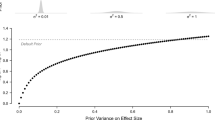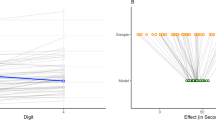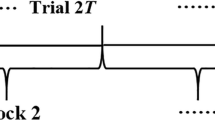Abstract
In many psychological research domains stimulus-response profiles are explained by conjecturing a sequential process in which some variables mediate between stimuli and responses. Charting sequential processes is often a complex task because (1) many possible mediating variables may exist, and (2) interindividual differences may occur in the relationship between these mediating variables and the response. Recently, Ceulemans and Van Mechelen (Psychometrika 73(1):107–124, 2008) addressed these challenges by developing the CLASSI model. A major drawback of CLASSI is that it requires information about the same set of stimuli for all participants (i.e., crossed data), whereas recently a number of data gathering techniques have been proposed in which the set of stimuli differs across participants, yielding nested data. Therefore we present the CLASSI-N model, which extends the CLASSI model to nested data. A simulated annealing algorithm is proposed. The results of a simulation study are discussed as well as an application to data concerning depression.
Similar content being viewed by others
References
Aarts, E., Korst, J., & Michiels, W. (2005). Simulated annealing. In E.K. Burke & G. Kendall (Eds.), Search methodologies (pp. 187–210). New York: Springer.
Barrett, L.F., & Barrett, D.J. (2001). An introduction to computerized experience sampling in psychology. Social Science Computer Review, 19(2), 175–185.
Bigné, J.E., Mattila, A.S., & Andreu, L. (2008). The impact of experiential consumption cognitions and emotions on behavioral intentions. Journal of Services Marketing, 22(4), 303–315.
Brusco, M.J. (2001). A simulated annealing heuristic for unidimensional and multidimensional (city-block) scaling of symmetric proximity matrices. Journal of Classification, 18(1), 3–33.
Ceulemans, E., & Van Mechelen, I. (2008). CLASSI: a classification model for the study of sequential processes and individual differences therein. Psychometrika, 73(1), 107–124.
Chaturvedi, A., & Carroll, J.D. (1994). An alternating combinatorial optimization approach to fitting the INDCLUS and generalized INDCLUS models. Journal of Classification, 11(2), 155–170.
Csikszentmihalyi, M., & Larsen, R. (1987). Validity and reliability of the experience-sampling method. Journal of Nervous and Mental Disease, 175(9), 526–536.
Davidson, R.J., Jackson, D.C., & Kalin, N.H. (2000). Emotion plasticity, context, and regulation: perspectives from affective neuroscience. Psychological Bulletin, 126(6), 890–909.
de Jong, S., & Kiers, H.A.L. (1992). Principal covariates regression. Part I. Theory. Chemometrics and Intelligent Laboratory Systems, 14(1–3), 155–164.
DeSarbo, W.S., Oliver, R.L., & Rangaswamy, A. (1989). A simulated annealing methodology for clusterwise linear regression. Psychometrika, 54(4), 707–736.
Dryden, W., & David, D. (2008). Rational emotive behaviour therapy: current status. Journal of Cognitive Psychotherapy: An International Quarterly, 22(3), 195–209.
Gross, J.J. (1998). Antecedent- and response-focused emotion regulation: divergent consequences for experience, expression, and physiology. Journal of Personality and Social Psychology, 74, 224–237.
Gross, J.J. (2001). Emotion regulation in adulthood: timing is everything. Current Directions in Psychological Science, 10(6), 214–219.
Gross, J.J. (2008). Emotion regulation. In M. Lewis, J. Haviland-Jones, & L. Barrett (Eds.), Handbook of emotions (pp. 497–512). New York: Guilford.
Gross, J.J., & John, O.P. (2003). Individual differences in two emotion regulation processes: implications for affect relationships and well-being. Journal of Personality and Social Psychology, 85(2), 348–362.
Haggard, E.A. (1958). Intraclass correlation and the analysis of variance. Troy: Dryden.
Hartigan, J.A. (1975). Clustering algorithms. New York: Wiley.
Hemenover, S.H., Augustine, A.A., Shulman, T., Tran, T., & Barlett, C.P. (2008). Individual differences in negative affect repair. Emotion, 8(4), 468–478.
Hubert, L., & Arabie, P. (1985). Comparing partitions. Journal of Classification, 2(1), 193–218.
Kirk, R.E. (1995). Experimental design: procedures for the behavioral sciences. Belmont: Brooks and Cole.
Kirkpatrick, S., Gelatt, C.D., & Vecchi, M.P. (1983). Optimization by simulated annealing. Science, 220(4598), 671–680.
Knuth, E.J., Stephens, A.C., McNeil, N.M., & Alibali, M.W. (2006). Does understanding the equal sign matter? Evidence from solving equations. Journal for Research in Mathematics Education, 37(4), 297–312.
Koole, S.L. (2009). The psychology of emotion regulation: an integrative review. Cognition and Emotion, 23(1), 4–41.
Kuppens, P., Van Mechelen, I., & Rijmen, F. (2008). Towards disentangling sources of individual differences in appraisal and anger. Journal of Personality, 76(4), 969–1000.
Leenen, I., & Van Mechelen, I. (2001). An evaluation of two algorithms for hierarchical classes analysis. Journal of Classification, 18(1), 57–80.
Li, T. (2005). A general model for clustering binary data. In KDD’05: Proceedings of the eleventh ACM SIGKDD international conference on knowledge discovery in data mining (pp. 188–197). New York: ACM.
Mischel, W., & Shoda, Y. (1998). Reconciling processing dynamics and personality dispositions. Annual Review of Psychology, 49(1), 229–258.
Nolen-Hoeksema, S., Wisco, B.E., & Lyubomirsky, S. (2008). Rethinking rumination. Perspectives on Psychological Science, 3(5), 400–424.
O’Brien, T.B., & DeLongis, A. (1996). The interactional context of problem-, emotion-, and relationship-focused coping: the role of the big five personality factors. Journal of Personality, 64(4), 775–813.
Radloff, L.S. (2006). The CES-D scale: a self-report depression scale for research in the general population. Applied Psychological Measurement, 1, 385–401.
Robinson, N.S., Garber, J., & Hilsman, R. (1995). Cognitions and stress: direct and moderating effects on depressive versus externalizing symptoms during the junior high school transition. Journal of Abnormal Psychology, 104(3), 453–463.
Roseman, I.J., & Smith, C.A. (2001). Appraisal theory: overview, assumptions, varieties, controversies. In K.R. Scherer, A. Schorr, & T. Johnstone (Eds.), Appraisal processes in emotion: theory, methods, research (pp. 3–19). London: Oxford University Press.
Scherer, K.R. (1999). Appraisal theory. In T. Dalgleish & M. Power (Eds.), Handbook of cognition and emotion (pp. 637–663). Chichester: Wiley.
Shafer, A.B. (2006). Meta-analysis of the factor structures of four depression questionnaires: Beck, CES-D, Hamilton, and Zung. Journal of Clinical Psychology, 62, 123–146.
Steinley, D. (2004). Properties of the Hubert-Arabie adjusted Rand index. Psychological Methods, 9(3), 386–396.
Trejos, J., & Castillo, W. (2000). Simulated annealing optimization for two-mode partitioning. In W. Gaul & R. Decker (Eds.), Classification and information at the turn of the millenium (pp. 135–142). Heidelberg: Springer.
Van Mechelen, I., & Hennes, K. (2009). The appraisal basis of anger occurence and intensity revisited. Cognition and Emotion, 23(7), 1373–1388.
Wilderjans, T.F., Ceulemans, E., & Van Mechelen, I. (2008). The CHIC model: a global model for coupled binary data. Psychometrika, 73(4), 729–751.
Author information
Authors and Affiliations
Corresponding author
Rights and permissions
About this article
Cite this article
Vande Gaer, E., Ceulemans, E., Van Mechelen, I. et al. The CLASSI-N Method for the Study of Sequential Processes. Psychometrika 77, 85–105 (2012). https://doi.org/10.1007/s11336-011-9235-3
Received:
Revised:
Published:
Issue Date:
DOI: https://doi.org/10.1007/s11336-011-9235-3




